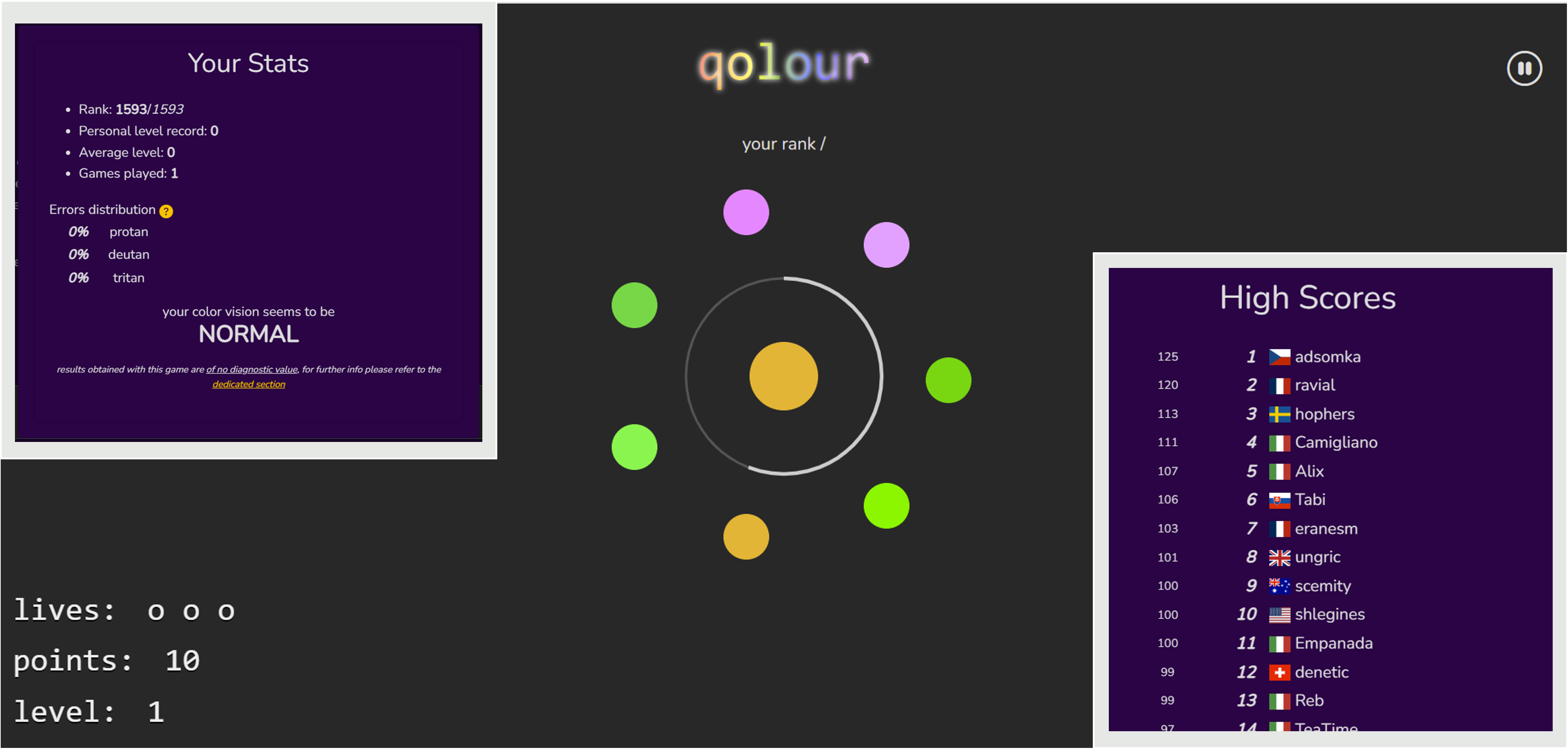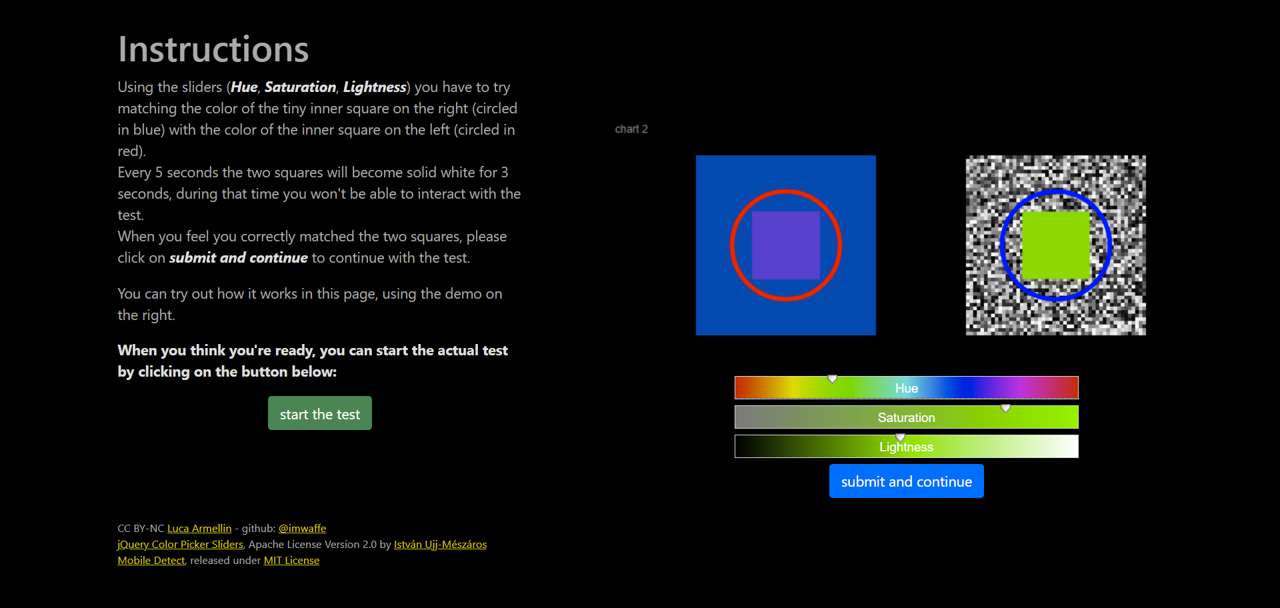Human Vision
Research on Perception is aimed at having a better understanding on how the human visual system works, by studying and modeling the retina and its functioning, including issues related to Color Vision Deficiencies, exploring the retinal-cortical color theory.
qolour
Trying to investigate the role of edges in the color perception of color vision deficient people requires complex unstandardized
setups, possibly leading to longer and more challenging tests. Besides the fact that only less than a tenth of the western population
shows some form of color blindness, adding inherent complexity to test setups may likely worsen the scenario and further reduce the
availability of test subjects. A possible solution might come from the development of web-based tests, which on the one hand makes it
easier for a subject to be enrolled in a study, on the other introduces variability in the form of different devices, environmental and
viewing conditions. Not being able to directly monitor a subject also makes it impossible to evaluate its attention and motivation, which
likely have a role in the accuracy of the responses given.
The purpose of qolour is to investigate the usage of trivial and simple online games for assessing and researching color
vision perception, with a special attention towards color vision deficiencies.
We collect anonymous data everytime you play, including the errors and the type of errors you commit during the game.
At the end of the game you will be presented with a chart showing on which colors you failed and a global assessment which takes into considerations
all the times you played.
Game designed and implemented by Luca Armellin see Team Page.
ARE YOU READY? LET'S PLAY!

CORISAMIL Project: NAD (Nuovo Approccio al Daltonismo)
Screening del daltonismo in profili operativi complessi del volo militare: studio e analisi di nuove metodologie di diagnostica alternativa
Il daltonismo è una condizione patologica in cui si ha un’alterata percezione dei colori, principalmente su base genetica ma con varianti secondarie a patologie che colpiscono le vie ottiche.
Tale condizione fu identificata, per la prima volta, da John Dalton nel 1794. Ad oggi sono disponibili diversi test per la determinazione del daltonismo quali le tavole di Ishihara, il test di Farnsworth,
o strumentazioni quali l’anomaloscopio ed il Color Assessment Diagnosis (CAD) test. La caratteristica comune a tutti questi test è di essere basati su configurazioni di stimolazione cromatica che evitano
la presenza di bordi (intesi come punti di contatto) tra le patch cromatiche di cui si testa la discriminazione. L'articolazione della complessa frequenza spaziale dello stimolo è sempre molto semplificata poiché
l’assenza di contatto tra colori e quindi di bordi, rende lo stimolo luminoso presentato estremamente semplice da elaborare per il sistema visivo umano.
I test visivi attualmente in uso presentano delle limitazioni legate all’assenza dei bordi la cui importanza nel contribuire alla formazione della sensazione cromatica è stata ampiamente dimostrata.
Inoltre, l’assenza dei bordi rende gli stimoli visivi semplici e non rappresentativi delle condizioni reali operative in cui i soggetti si trovano ad operare nella pratica quotidiana.
Lo sviluppo di nuovi test, caratterizzati dalla presenza di bordi, consentirebbe di valutare più adeguatamente la capacità di distinzione dei colori e conseguentemente l’elaborazione di stimoli complessi.
L’utilizzo di tali nuovi test, in ausilio a quelli precedentemente in uso, nello screening di soggetti destinati ad attività di volo militare, permetterebbe una riduzione della quota dei candidati non idonei, ai sensi delle norme di legge e dei regolamenti attuativi in vigore, sia nel personale impiegato in forma diretta, quali i piloti, che indiretta, quali meteorologi o controllori dello spazio aereo. L’elaborazione di test alternativi e complementari a quelli già utilizzati per la diagnosi di daltonismo, consentirebbe di ottenere una più accurata misura del grado e del tipo di discromatopsia. Tali test inoltre potrebbero fornire informazioni utili ad interpretare quelli già esistenti, al fine di comprendere quali test consentono di ottenere il maggior numero di informazioni cliniche e diagnostiche di tipo quantitativo.
Lo studio si svolgerà in due sedi:
-
Istituto di Medicina Aerospaziale dell'Aeronautica Militare di Roma, Viale Piero Gobetti, 2, 00185 Roma.
-
Dipartimento di Informatica dell’Università degli Studi di Milano, Via Celoria 18, 20133 Milano.
Color deficiency in complex spatial contexts
Test your ability to match colors and help us in the development of new methods of screening for color deficiency.
The test is avaiable at this link in ITALIAN and ENGLISH: https://mips.di.unimi.it/simultaneous-contrast/
Test developed by Luca Armellin .

Spatial and functional models of human retina
Retina characteristics and structure are often presented as well-known, however there are still several
points to assess, like the total number of photoreceptors, the number of axons converging in the optical
nerve and the size of the rod-free zone in the fovea. Retinal photoreceptor topography is also correlated to
various perception phenomena, like the filling in taking place in the retinotopic region corresponding to the
optic disk, and the differences in M to L cone ratio leading to no significant intersubjective differences in
sensation, aspects that are still not fully explained.
Our research on the retina is focused on investigating the parameters that regulate the spatial distribution of
photoreceptors in the human retina, and how the highly variable ratio of L to M cones between individuals
affects our perception of color. To do this we are developing a model and its implementation of a human
retina, to apply statistical models of photoreceptors distributions and create a functional model that
will allow to simulate the photoreceptors’ behavior in relation to the phototransduction of the visual signals
and the elaboration of these signals in the retinal circuitry, to gain more insights on unclear aspects of
how a light stimulus relates to the perception of color and to understand the nonlinear process of human
vision.
Human vision uses complex spatial processing to calculate appearance from retinal arrays. Hence,
physiological limits of the human visual system are also to be considered, in particular veiling glare,
defined as an uncontrolled spread of an image-dependent fraction of scene luminance in cameras and in the eye,
is a strong component of our vision and one of the main issues of High Dynamic Range imaging.
Retinal and post retinal spatial image processing increases apparent contrast, counteracting glare.
Research on the HVS also includes issues related to Color Vision Deficiency (CVD), also referred to as
color blindness, and image processing techniques used to improve images for people with CVD, called
Daltonization methods, consisting in a series of color correction algorithms that modify content in order
to make it accessible for CVD observers. Details about our works on our HVS can be found in.
Publications
Book Chapters
A. Rizzi, C. Bonanomi, “The human visual system described through visual illusions”, in Colour design: theories and applications, Woodhead Publishing: Ms Janet Best (ed). – 2nd edition, pp. 23-41, 2018, ISBN: 978-0-08-101270-3, DOI: https://doi.org/10.1016/B978-0-08-101270-3.00002-3Get.
A. Rizzi, C. Bonanomi, “Colour illusions and the human visual system”, in Colour design: theories and applications, Janet Best Ed., Woodhead Publishing, March 2012, ISBN 1 84569 972 6, DOI: https://doi.org/10.1533/9780857095534.1.83.
J.J. McCann, V. Vonikakis, A. Rizzi, C. Parraman, “Report on the 3-D colour Mondrian project: Reflectance, illumination, appearance and reproduction”, in Colour-Coded, pp. 129-150, December 2010, ISBN 978-0-901956-86-6.
G. Ciocca, D. Marini, A. Rizzi, R. Schettini, S. Zuffi, “Retinex Preprocessing of Uncalibrated Images for Color Based Image Retrieval”, selected for Virtual Journal of Biological Physics Research, February 2003, DOI: https://doi.org/10.1117/1.1526844.Papers on international journals
Rizzi A., Plutino A., Vecchi D., Guadagno A. G., Lucertini M., “Dynamic Range of Luminance Perception in Acute Hypobaric Hypoxia”, High Altitude Medicine & Biology, 2022, DOI: 35914060
Plutino A., Scipioni S., Lombardi C. A., Giuliani L., Mazzoni A., Marcucci R. and Rizzi A., “A test on color discrimination in complex scenes for a better comprehension of color blindness”, Color Culture and Science Journal, Vol. 13 (2), pp. 72-83, 2021, DOI: 10.23738/CCSJ.130209b.
M. Lanaro, H. Perrier, D. Coeurjolly, V. Ostromoukhov, A. Rizzi, " Blue-noise sampling for human retinal cone spatial distribution modeling", Journal of Physics Communications, Volume 4, Issue 3, March 2020, DOI: https://doi.org/10.1088/2399-6528/ab8064.
M. Tanaka, M.P. Lanaro, T. Horiuchi, A. Rizzi, “Random Spray Retinex Extensions Considering ROI and Eye Movements”, Journal of Imaging Science and Technology, Volume 63, Issue 6, pp. 60403-1-60403-6, , November 2019, DOI: https://doi.org/10.2352/J.ImagingSci.Technol.2019.63.6.060403.
C. Bonanomi, S. Balletti, M. Lecca, M. Anisetti, A. Rizzi, E. Damiani “I3D: a new dataset for testing denoising and demosaicing algorithms”, Multimedia Tools and Applications, Volume 79, Issue 13-14, pp. 8599 - 8626, July 2018, DOI: https://doi.org/10.1007/s11042-018-6396-4.
G. Gianini, A. Rizzi, “A Fuzzy Set Approach to Retinex Spray Sampling”, Multimedia Tools and Applications, Volume 76, Issue 23, pp. 24723-24748, June 2017, DOI: https://doi.org/10.1007/s11042-017-4877-5.
M. Lecca, C. M. Modena, A. Rizzi, “Using pixel intensity as a self- regulating threshold for deterministic image sampling in Milano Retinex: the T-Rex algorithm”, Journal of Electronic Imaging, Volume 27, Issue 1, pp. 011005-1 - 011005-11, January 2018, DOI: https://doi.org/10.1117/1.JEI.27.1.019801.
C. Bonanomi, S. Sarioli, S. Mascetti, G. Gianini, V. Alampi, M. Lanaro, A. Rizzi, “An App-based Assessment of SiChaRDa, an Image Enhancer for Color-Blind People”, Journal of Imaging Science and Technology, Volume 61, Issue 4, pp. 40405-1-40405-9, July 2017, DOI: https://doi.org/10.2352/J.ImagingSci.Technol.2017.61.4.040405.
M.P. Lanaro, C. Bonanomi, A. Rizzi, “Open Issues in the Study of Human Retina”, Journal of the International Colour Association, Volume 20, pp. 1-11, 2017, DOI: https://www.aic-color.org/resources/Documents/jaic_v20_01.pdf.
S. Mascetti; D. Ahmetovic; A. Gerino; C. Bernareggi; M. Busso; A. Rizzi, “Robust Traffic Lights Detection on Mobile Devices for Pedestrians with Visual Impairment”, Computer Vision and Image Understanding, Volume 148, pp. 123-135, July 2016, DOI: https://doi.org/10.1016/j.cviu.2015.11.017.
A. Rizzi, D. Fogli, B. R. Barricelli, “A New Approach to Perceptual Assessment of Human-Computer Interfaces”, Multimedia Tools and Applications, Volume 76, Issue 5, pp. 7381-7399, March 2016, DOI: https://doi.org/10.1007/s11042-016-3400-8.
G. Gianini, A. Rizzi, E. Damiani, “A Retinex model based on Absorbing Markov Chains”, Information Sciences, Volume 327, pp. 149–174, January 2016, DOI: https://doi.org/10.1016/j.ins.2015.08.015.
M. Lecca, A. Rizzi, “Tuning the locality of filtering with a spatially weighted implementation of random spray Retinex”, Journal of the Optical Society of America A, Volume 32, Issue 10, pp. 1876-1887, 2015, DOI: https://doi.org/10.1364/JOSAA.32.001876.
A. Rizzi, R. Eschbach, A. Quaranta, C. Bonanomi, “Modified Ishihara test to study the role of edges in color discrimination”, Italian Journal of Aerospace Medicine, Volume, July 2014, http://ijasm.altervista.org/index.php/ijasm/article/view/4, reprinted in Volume 13, July 2015, http://ijasm.altervista.org/index.php/ijasm/article/view/76.
J.J. McCann, A. Rizzi, “Retinal HDR Images: Intraocular Glare and Object Size” Journal of the Society for Information Display, Volume 17, Issue 11, pp. 913-920, 2009, DOI: https://onlinelibrary.wiley.com/doi/abs/10.1889/JSID17.11.913.
M. Bertalmio, V. Caselles, E. Provenzi, A. Rizzi, “Perceptual Color Correction Through Variational Techniques” IEEE Transactions on Image Processing, Volume 16, Issue 4, pp. 1058-1072, March 2007., DOI: https://doi.org/10.1109/TIP.2007.891777.
A. Rizzi, D. Gadia, D. Marini, “Analysis of tristimulus interdifference and contextual color correction” Journal of Electronic Imaging, Volume 15, Issue 4, 041202, December 2006, DOI: https://doi.org/10.1117/1.2372799.Papers on national journals
A. Rizzi, A. Plutino, "Sulle condizioni di somministrazione del test di Luscher", in PSYCHE NUOVA, Anno XXXVI, nuova serie 2019, ISSN 1128-1480, 2019.Conference Proceedings
S. Scipioni, C.A. Lombardi, L. Giuliani, A. Plutino, A. Rizzi, “Verso una più ampia comprensione del daltonismo: un test sulla discriminazione di colori in scene complesse”, XVI Conferenza del Colore, Colore e Colorimetria - Contributi Multidisciplinari - Vol. XVIA, pp. 63-70, Bergamo (Italy), 3-4 September 2020, https://www.gruppodelcolore.org/wp-content/uploads/2020/11/ColoreEcolorimetriaContributiMultidisciplinari_VolXVIA-1.pdf.
M.P. Lanaro, H. Perrier, D. Coeurjolly, V. Ostromoukhov, A. Rizzi, “Towards human retinal cones spatial distribution modeling” MODVIS 2019: Computational and Mathematical Models in Vision, St. Pete Beach (FL, USA), 15-17 May 2019, https://docs.lib.purdue.edu/cgi/viewcontent.cgi?article=1148&context=modvis.
